The Amphibian Forum
The Amphibian forum is a place for members to share good practice and ask questions about amphibians and their general care. It is free to register and easy to use. There are plenty of regular members, so any queries about amphibian care, breeding, health and keeping should be answered within a short space of time, whether you keep frogs, toads, newts, salamanders or Caecilians you can find some good advice in the amphibian forum.
Frequently Asked Questions.
The Amphibian.co.uk Forum is a good place to gain advice and feedback which is personalised for your specific problem or enquiry. We always welcome any questions you may have regarding your amphibian and our members will eagerly offer friendly and informed answers. Here are a few frequently asked questions that may help you in your search for Amphibian related advice.
What amphibian species make good pets for new and in-experienced amphibian keepers?
There are a few species that are commonly kept in captivity that are quite hardy, so are more suitable for beginners than some other types of amphibian.
If you are interested in keeping a frog or a toad (Anurans), then Horned Frogs (Ceratophrys cranwelli), Fire-Bellied Toads (Bombina orientalis), White’s Tree Frogs (Litoria caerulea) and most toads from the family Bufo are relatively easy to care for, whilst Fire Salamanders (S.salamandra salamandra) and Fire-Bellied Newts (Cynops pyrrhogaster) are good beginner’s choices for newt and salamander species (Caudata).
When making a decision on which type of amphibian is right for you research should play a key role in your preparations. All amphibians that can be kept in captivity should be researched extensively by both beginners and experienced keepers before they are purchased. It is always important to be 100% certain you can provide the care needs required for that species, regardless of your experience with amphibians.
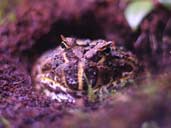 |
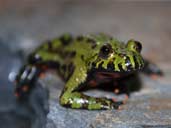 |
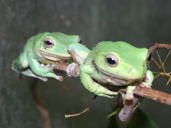 |
 |
Cranwell's Horned Frog |
Fire-Bellied Toad Bombina orientalis |
White's Tree Frogs Litoria caerulea |
Fire Salamander Salamandra salamandra |
What type of food do amphibians eat?
Generally amphibians are insectivores and will eat a wide variety of appropriately sized insects and similar creatures such as earthworms, slugs and snails. It is important to check as many care sheets and books specifically about your species of amphibian to find out what insects are suitable for your pet to eat.
All amphibian species appreciate variety in their diet and it is not healthy to feed your amphibian on just one type of food alone. Live foods are widely available from reptile stockists and online and it may even be possible to source your insects from outside in the wild, if you can guarantee the area you are collecting from is chemical/fertiliser free.
All feeder insects should be gut-loaded prior to feeding to your amphibians. Gut-loading is the practice of feeding your insects with highly nutritious food items that will make the feeder insects more beneficial to the health of your amphibian. Prepared gut-loading formulas can be purchased from reptile suppliers, but it is also very simple to give your insects a nutritious diet without ready-made products. Green vegetables and salad leaves are packed with vitamins and in most cases provide all the water needed to keep your insects healthy. Other good food items that can be used for gut-loading are oats, bran, flaked fish food and calcium-rich foods like dandelion leaves and powdered milk powder. Carrot and potato peelings are also usually readily taken by most feeder insects.
Insects should be dusted with vitamins and calcium prior to being fed to your pets, but research should be done to find out how frequently your species of amphibian requires vitamins and minerals. The simplest way to dust your insects is using the ‘shake and bake’ method, where you place some of your vitamin and calcium powder into a plastic tub or bag, followed by your insects and shake them together until the food item is completely covered in powder, then serve.
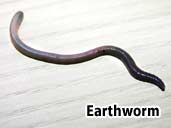 |
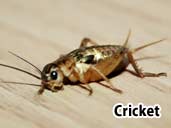 |
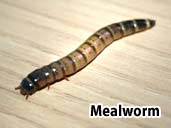 |
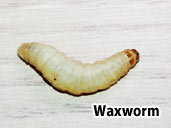 |
Is de-chlorinated water essential for amphibians?
Amphibians are very sensitive to chemicals and pollutants in a water source because they have water-permeable skin. Chlorine, which is added to normal tap water is beneficial to humans, but is not so suitable for our amphibian pets. All water used in the keeping of your amphibians should be de-chlorinated before use. This includes water in drinking bowls, in aquatic and semi-aquatic set ups and even in the spray bottle you would use for misting the terrarium.
Tap water can be de-clorinated by leaving it to stand uncovered for 24 hours before use, as this allows the chlorine to evaporate, or by adding a shop bought water conditioning treatment such as ZooMed Reptisafe, which eliminates chlorine and chloramines and adds Calcium and other Electrolytes which are beneficial to your amphibians. Bottled spring water and rain water that is pollution-free is also suitable for use.
Keeping water clean is very important in amphibian keeping, as nitrates and toxins can build up quickly when amphibians soak themselves in their water bowl. They are also likely to use the water bowl as the main area to defecate in, so daily water changes are recommended to keep bacteria levels at a minimum.
What plants are safe to use in an amphibian terrarium?
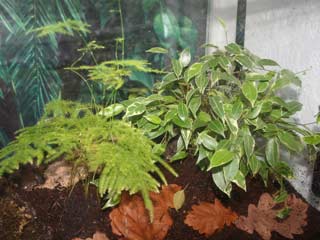 Ensuring the suitability of any live plant that you are considering to place within the terrarium is very important, as some plants may be toxic to your amphibian. You should always research a new species of plant that you want to use in the terrarium, to ensure that it is safe to use and that it will not be an irritant to your pet. You should also ensure that the plant is suitable for the conditions within the terrarium; otherwise it may wither and die if conditions such as temperature, light and humidity are not suitable for it.
Ensuring the suitability of any live plant that you are considering to place within the terrarium is very important, as some plants may be toxic to your amphibian. You should always research a new species of plant that you want to use in the terrarium, to ensure that it is safe to use and that it will not be an irritant to your pet. You should also ensure that the plant is suitable for the conditions within the terrarium; otherwise it may wither and die if conditions such as temperature, light and humidity are not suitable for it.
Some popular plants to use in amphibian housing include Bromeliads, ferns such as the Bird’s Nest Fern & Java Fern, Wandering Jew, Creeping Fig, Devil’s Ivy, Live Moss such as Java Moss, Orchids and Draeceana. Live plants should always be sourced from somewhere that you can guarantee that they have been grown using fertilizer-free methods to avoid any chemicals being introduced to your amphibian’s home.
There is a ‘Live Plants’ section on the main forum if you have any more questions about the suitability of certain plants for you amphibian set up.
Can different species of amphibian be kept together in the same terrarium?
It is unadvisable to try and keep multiple species of amphibian within the same terrarium. Many problems can arise from doing so, some of which can be fatal to one or more of the amphibians housed in this way. Many amphibians are cannibalistic towards smaller cage mates and different species may grow and develop at different rates making this much more likely. Some species also emit toxins that can kill or irritate other types of amphibian.
All amphibians have their own specific needs and preferences, so housing multiple species together would mean that it would be much harder to regulate the environment to suit those amphibians perfectly. Stress could become a major issue in these circumstances, meaning that your amphibians would be more prone to illness and disease from having inappropriate conditions and competition from another species that may be more adaptive to the environment.
If you do decide to house different species of amphibians together, then you should be a very experienced amphibian keeper who has researched the care needs of the species involved thoroughly. Species should be equal in size, non-toxic and require very similar set-ups. You will also need to be prepared and equipped to separate the species if any problems do arise, as well as being willing and able to seek vetinary advice when required.
Are amphibians susceptible to any health problems?
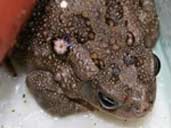 |
Fungal Infection |
Amphibian illness can usually be avoided through good husbandry, as Amphibians that are without clean vivaria, fresh water and a balanced diet are more susceptible to disease and illness than amphibians who are given appropriate care.
Some of the common illnesses in amphibians include bacterial and fungal infections, Red Leg (caused by parasites), Dropsy (an accumulation of bodily fluids), Impaction (a blockage in the digestive tract), Stress and MPD (Metabolic Bone Disease caused by insufficient calcium in an amphibian’s diet). Most of these illnesses can be avoided, but if you believe your amphibian is suffering from any of the above then it is advisable to see a specialised exotics vet as soon as possible.
Still Got Questions?
Then please enter the forum. Our regular members will welcome your question and it would be great to have you as part of TheAmphibian.co.uk community.

